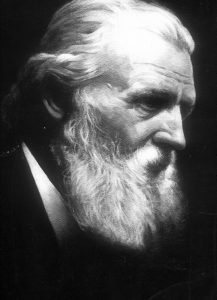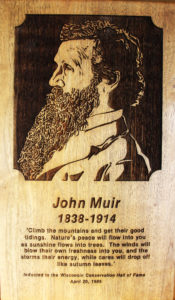1838 – 1914
Inducted 1985
“When we try to pick out anything by itself, we find it hitched to everything else in the Universe.” – John Muir
As a boy, John Muir immigrated with his family from Scotland to a Wisconsin farm near Portage. As an explorer, naturalist, author and political activist, he made early conservation history. Muir spent much of his adult life traveling the continent on foot, keeping vivid journals of his wilderness experiences. A founder of the Sierra Club, he played key roles in establishment of Yosemite National Park and other important additions to the national parks and forest systems.
Muir’s childhood days on a farm near Portage helped shape him into the man he would become.
Muir was a conservation icon in America and the world. A naturalist, explorer and writer, he was an influential conservationist, who worked to preserve wilderness areas and wildlife from commercial exploitation and destruction. Muir’s work helped to establish Yosemite National Park and Sequoia National Park, both in California. Many natural sites have been named in his honor, including Muir Woods National Monument, a virgin stand of redwoods, near San Francisco, California.
 Muir was born in Scotland in 1838. His family immigrated to the United States when he was 11 years old. Muir attended the University of Wisconsin from 1860 to 1863 but did not graduate. When he left college, he took extensive walking trips to study nature, especially plants. In 1867 he made a walking trip from Indianapolis to the Gulf of Mexico to observe the plants, animals and physical features of the country. During this trip Muir kept extensive journals, which were published after his death as A Thousand Mile Walk to the Gulf.
Muir was born in Scotland in 1838. His family immigrated to the United States when he was 11 years old. Muir attended the University of Wisconsin from 1860 to 1863 but did not graduate. When he left college, he took extensive walking trips to study nature, especially plants. In 1867 he made a walking trip from Indianapolis to the Gulf of Mexico to observe the plants, animals and physical features of the country. During this trip Muir kept extensive journals, which were published after his death as A Thousand Mile Walk to the Gulf.
In 1868 Muir went to Yosemite Valley in California and explored and studied the area for the next six years. He argued forcefully that people should defend species and wilderness areas from devastation by humans. In 1889 he initiated a movement to preserve the sequoias in the Yosemite Valley and the surrounding area. In 1890 his efforts led Congress to establish Yosemite and Sequoia national parks.
In 1892 Muir and some of his supporters founded the Sierra Club, dedicated to the exploration and preservation of American wildlife and wilderness. He also influenced President Theodore Roosevelt to set aside national monuments, national forest reserves, and national parks.
Muir was one of the first two inductees into the Wisconsin Conservation Hall of Fame. The other was Aldo Leopold, another world-famous conservationist who had his roots in Wisconsin. Together, the two men stand as twin towers of conservation and are featured on the logo for the Wisconsin Conservation Hall of Fame.
Resources
John Muir WCHF Induction Speech, by Patty Dreier, 1986
John Muir, Wisconsin Historical Society
John Muir’s Wisconsin Roots, article by Andrea Nelson, Door County Pulse, 2016
John Muir’s Wisconsin Days, article by Dave Leshuk, WI Natural Resources Magazine, 1988
Tour Wisconsin’s John Muir Nature and History Route, Travel Wisconsin
John Muir National Historic Site
John Muir biographical resources, Sierra Club
John Muir, Britannica Online Encyclopedia
John Muir’s Yosemite, article by Tony Perottete, Smithsonian Magazine, 2008
A Genius in the Best Sense, 1993
Wisconsin’s Environmental Tradition: A Reader (PDF)
Download Muir’s Books (Free ebooks and audiobooks from The Internet Archive)
The Story of My Boyhood and Youth (1913)
A Thousand-Mile Walk to the Gulf (1916)
My First Summer in the Sierra (1911)
The Yosemite (1912)
The Mountains of California (1894)
Our National Parks (1901)
Steep Trails (1919)
Muir’s other writings available free online
Digital Public Library of America
See Muir’s Manuscripts at the Wisconsin Historical Society
30 original manuscript letters of Muir, 1861-1914
A visit to Muir in his UW dorm room, ca. 1862
Muir’s younger brother recalls their boyhood
Photos
These images may be used under the Creative Commons Attribution-NonCommercial-NoDerivatives 4.0 International License.










